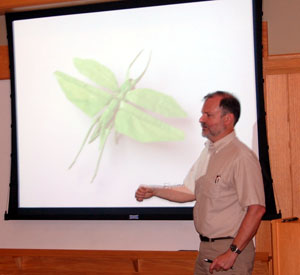- About MAA
- Membership
- MAA Publications
- Periodicals
- Blogs
- MAA Book Series
- MAA Press (an imprint of the AMS)
- MAA Notes
- MAA Reviews
- Mathematical Communication
- Information for Libraries
- Author Resources
- Advertise with MAA
- Meetings
- Competitions
- Programs
- Communities
- MAA Sections
- SIGMAA
- MAA Connect
- Students
- MAA Awards
- Awards Booklets
- Writing Awards
- Teaching Awards
- Service Awards
- Research Awards
- Lecture Awards
- Putnam Competition Individual and Team Winners
- D. E. Shaw Group AMC 8 Awards & Certificates
- Maryam Mirzakhani AMC 10 A Awards & Certificates
- Two Sigma AMC 10 B Awards & Certificates
- Jane Street AMC 12 A Awards & Certificates
- Akamai AMC 12 B Awards & Certificates
- High School Teachers
- News
You are here
From Flapping Birds to Space Telescopes: The Modern Science of Origami

Lang shows the crowd an origami katydid. Photo by Ryan Miller.
The title “From Flapping Birds to Space Telescopes” may not sound like a talk on the ancient art of paper folding and the surprising amount of mathematics that goes into origami design. But in a recent distinguished lecture at the MAA Carriage House Conference Center, Robert Lang made a compelling case for the many mathematical components that play a role in modern origami.
One of the foremost origami artists in the world as well as a pioneer in computational origami, Lang began his talk by going over the simple rules that underlie crease patterns. The first rule states that every folding pattern is two-colorable. “If you think of it as a map of countries, you need only two colors to color every region so that no two of the same color touch,” Lang said.
The second rule concerns mountain and valley folds, the building blocks of all origami structures: the total number of mountain folds and the total number of valley folds must differ by two. The third rule involves the angles of each vertex where folds meet: The sum of every other angle surrounding an interior vertex equals 180°.
The final rule, which Lang described as the trickiest of the four, states that a sheet can never penetrate a fold. The difficulty of assigning folds to satisfy this rule was proved about ten years ago when two computer scientists discovered that assigning mountain and valley folds in a crease pattern to produce a flat model is equivalent to a logic problem that is computationally NP-complete.
Designing intricately detailed, remarkably realistic models brings more mathematics into play. Lang noted that the mathematical problem of circle packing offers a way to work out how much paper a particular model requires. A circle identifies the least amount of paper that one must allocate for making a flap. Each flap then becomes an appendage, such as a spider’s leg or a deer antler’s prong.

A white-tailed deer. Photo courtesy of Robert Lang.
Some people still use pencil and paper to draw such circle arrangements when they design complex models, but computer programs have now made this process much easier. Lang’s own program TreeMaker uses circle-packing algorithms to turn a stick figure into a crease pattern. He showed a number of stunning designs, including a white-tailed deer and a flying katydid, to illustrate how computer programs can make specific crease patterns.
Computer-aided design has led to a “can you top this?” battle of sorts among the world’s best origami artists, with models getting smaller, more complicated, and more detailed. However, even though computers play a large role in origami today, every finished product still has traits unique to its individual folder, Lang pointed out.
Lang recalled a Japanese folder who would fold Lang’s own designs into intricate models that nonetheless differed from Lang’s versions. “I could look at his and couldn’t put my finger on anything because it was just subtle shaping, but it was unmistakably his,” Lang said.
Origami design also has practical applications, from solar sails to auto airbags. Lang, for example, worked with engineers at the Lawrence Livermore National Laboratory to design a folding pattern for a 100-meter-wide telescope lens that had to be carried into space on a much smaller rocket.
Lang also discussed origami’s applications in the medical field. Folding patterns have been useful in modeling cell membranes and proteins as well as in the design of an expandable artery stent. —R. Miller
 Listen to Robert Lang’s lecture
Listen to Robert Lang’s lecture

This MAA Distinguished Lecture was funded by the National Security Agency.




